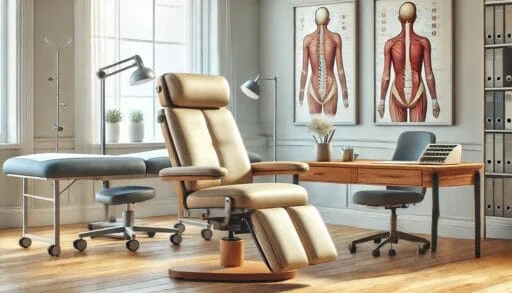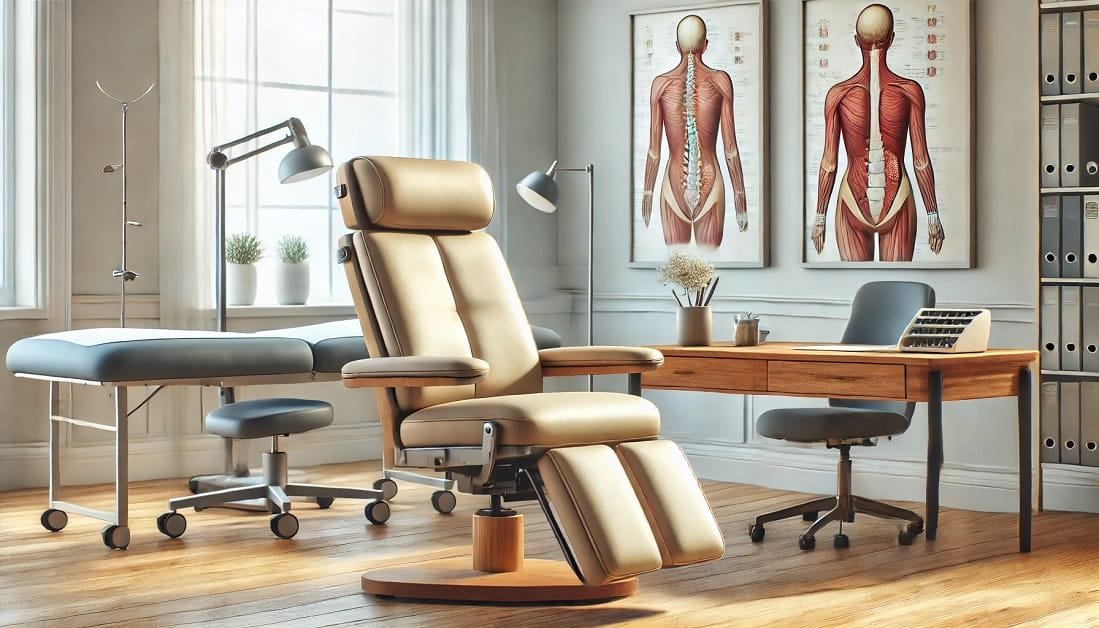Introduction
Menopause is a natural phase in a woman’s life, but it can bring about numerous physical challenges, with back pain being one of the most common and often debilitating symptoms. As hormone levels fluctuate, women experience changes in their bodies that can lead to discomfort, aches, and stiffness, particularly in the back. If you’ve been searching for how to treat menopause back pain, you’re not alone.
It’s important to address back pain during menopause as it can significantly affect your daily routine and overall well-being. Whether it’s due to hormonal shifts, posture changes, or weight gain, this discomfort can hinder everything from getting out of bed in the morning to enjoying everyday activities. Fortunately, there are various proven solutions and effective tips to help you manage and relieve menopause back pain. In this blog, we will explore the most effective treatments, lifestyle changes, and natural remedies to get you back to feeling your best.
Table of Contents
Understanding Menopause and Its Effects on the Body
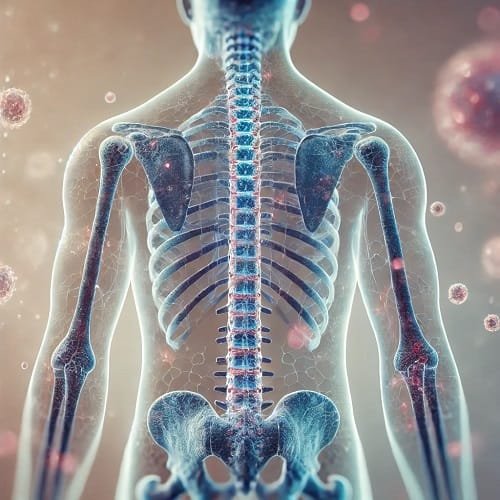
Menopause marks the end of a woman’s menstrual cycle, typically occurring between the ages of 45 and 55. This natural biological process brings about a series of body changes due to a drop in the production of hormones like estrogen and progesterone. As a result, women experience a variety of menopause symptoms, including hot flashes, mood swings, and sleep disturbances. However, back pain during menopause is one of the most common and often under-discussed challenges that many women face.
The decrease in estrogen during menopause has significant effects on the body, particularly on the muscles, joints, and bones. Estrogen plays a vital role in maintaining bone density and muscle flexibility, and as these levels decline, women may experience muscle stiffness, joint pain, and even a reduction in bone mass. This hormonal imbalance can lead to an increase in back pain as the body’s support structures weaken, causing discomfort and even chronic pain in the lower back.
Additionally, other common menopause issues such as weight gain and changes in posture can exacerbate back pain. The added weight shifts the body’s center of gravity, placing extra strain on the spine. Women may also experience changes in their posture, further contributing to back pain during menopause. These factors combined can make daily activities more difficult, reducing quality of life and leading to frustration. Understanding these physiological changes is the first step in learning how to treat menopause back pain effectively.
Common Causes of Back Pain During Menopause
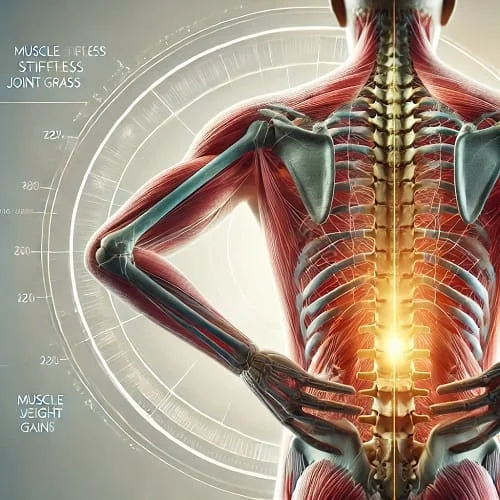
Understanding the causes of back pain during menopause is essential in learning how to treat menopause back pain effectively. One of the primary contributors to back pain during menopause is the reduction in bone density. As estrogen levels decline, bones lose strength and become more fragile. This leads to conditions like osteoporosis, which significantly increases the risk of fractures, especially in the spine, and is a major cause of back pain. These changes in bone structure make it more difficult to avoid discomfort, and understanding how to treat menopause back pain is key to managing this condition.
Another major factor contributing to back pain during menopause is muscle stiffness. As estrogen decreases, muscles and ligaments become less elastic, leading to tension and tightness. This lack of flexibility makes it more difficult for the muscles to support the spine, directly contributing to back pain during menopause. If left untreated, this can result in chronic discomfort and an inability to perform daily activities without pain. Learning how to treat menopause back pain becomes increasingly important as these changes progress.
Posture issues can also exacerbate back pain during menopause. Many women experience weight gain during menopause, which places additional stress on the back and leads to poor posture. The excess weight adds pressure on the spine, which can trigger back pain. How to treat menopause back pain in this context involves not just focusing on weight management but also improving posture through physical therapy or exercises designed to strengthen the core.
Additionally, arthritis and muscle weakness are major contributors to back pain during menopause. Osteoarthritis, which affects many women as they age, causes the cartilage in the joints to deteriorate, leading to pain and stiffness in the back. Muscle weakness, particularly in the core and back muscles, can contribute to instability and discomfort, making it harder to manage back pain. Knowing how to treat menopause back pain includes understanding these conditions and seeking the right treatments, from medication to physical exercises that strengthen the muscles.
Proven Solutions to Relieve Menopause Back Pain
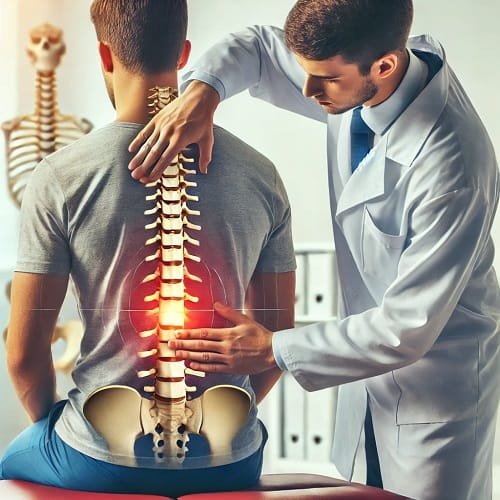
When it comes to how to treat menopause back pain, there are several effective treatments available that can help alleviate discomfort and restore mobility. Whether through physical therapies, chiropractic care, or natural methods, managing back pain during menopause is possible with the right approach. Below, we’ll explore some of the most proven solutions to help you find back pain relief and improve your overall quality of life.
Physical Therapy for Menopause Back Pain
One of the most effective treatments for menopause back pain is physical therapy. Tailored exercises designed by a physical therapist can target the specific muscles that support the spine. These exercises not only help strengthen the muscles but also improve posture, which is a common contributor to back pain during menopause. By focusing on building core strength and enhancing flexibility, physical therapy can reduce the strain on the lower back and improve your overall spinal alignment. Regular physical therapy sessions can provide long-term back pain relief, enabling you to perform daily activities with greater ease and comfort.
Chiropractic Care for Menopause Back Pain
Another popular solution to how to treat menopause back pain is chiropractic care. Chiropractic adjustments focus on spinal manipulation to realign the vertebrae, which can help reduce pressure on the nerves and joints in the back. This realignment can relieve tension and pain, particularly in the lower back. Many women find chiropractic care to be highly effective in managing back pain during menopause, as it targets the root cause of misalignments that can occur due to hormonal changes, weight gain, or posture issues. Consistent chiropractic treatments can provide significant back pain relief and improve mobility.
Massage Therapy for Menopause Back Pain
Massage therapy is another great option for how to treat menopause back pain. Deep tissue massage is especially beneficial for easing muscle tension and promoting relaxation. During menopause, muscle stiffness and discomfort are common due to changes in hormone levels, and massage therapy helps relieve this tension. It improves blood circulation to the muscles, reducing inflammation and promoting healing. Regular massage sessions can complement other treatments, providing both physical and mental relief, and significantly easing back pain associated with menopause.
Heat and Cold Therapy for Menopause Back Pain
Heat and cold therapy are simple but highly effective methods for managing menopause back pain. Applying a heating pad or warm compress can help improve blood flow and ease muscle stiffness in the back. Heat therapy is particularly effective for soothing chronic back pain and loosening tight muscles. On the other hand, cold therapy, such as ice packs, can help reduce inflammation and numb sharp pain, providing quick relief. Alternating between heat and cold can help manage both muscle tension and inflammation, making it an excellent choice for pain management.
Over-the-Counter Medications for Menopause Back Pain
For immediate back pain relief, over-the-counter medications can be useful in treating menopause back pain. Non-prescription pain relievers like ibuprofen or acetaminophen can help reduce inflammation and alleviate mild to moderate pain. Additionally, topical creams and gels containing menthol or capsaicin can provide localized relief for sore muscles. It’s important to use these medications as directed and consult with a healthcare provider if the pain persists or worsens.
In conclusion, there are several effective treatments for how to treat menopause back pain. From physical therapy and chiropractic care to heat therapy and over-the-counter medications, you can find a combination of solutions that work best for your body and lifestyle. Each of these methods targets different aspects of back pain relief, offering lasting benefits for those struggling with the discomfort of menopause.
ALSO READ
Can Menopause Cause Nausea? What Women Should Know
Menopause and Gastric Reflux: A Comprehensive Guide for Women
Heartburn During Menopause: Essential Tips for Women
POTS and Endometriosis: 7 Facts to Know
Abortion and Endometriosis: What Every Woman Should Know
Lifestyle Changes to Prevent and Manage Menopause Back Pain
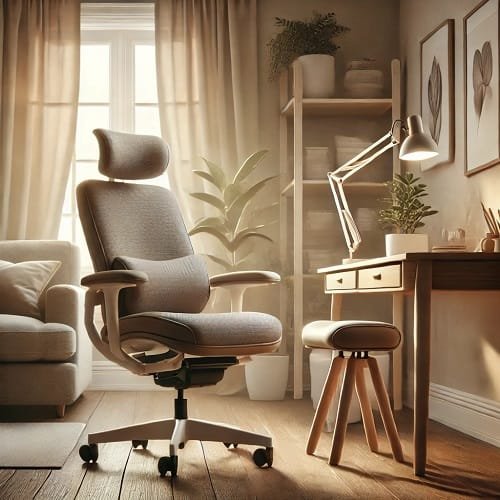
When addressing how to treat menopause back pain, making certain lifestyle changes can significantly help in preventing and managing discomfort. By focusing on a few key habits, you can reduce the strain on your back and improve your overall quality of life during menopause. Here are some lifestyle changes that can make a big difference.
Maintaining a Healthy Weight
One of the most important factors in how to treat menopause back pain is maintaining a healthy weight. Extra weight places additional pressure on the spine, especially in the lower back, which can exacerbate existing pain. During menopause, many women experience weight gain due to hormonal changes, making it essential to focus on weight management. A healthy weight reduces the stress on your spine and can alleviate the strain that contributes to back pain. Incorporating a balanced diet and regular exercise can help you manage your weight effectively, reducing back pain and promoting overall well-being.
Improving Posture
Proper posture correction is another effective way to treat menopause back pain. As your body changes during menopause, poor posture becomes more common. Slouching or hunching over can place additional stress on the back muscles and spine. To improve posture, be mindful of your alignment when sitting, standing, and walking. Make a conscious effort to keep your shoulders back, head aligned with your spine, and feet flat on the floor when sitting. This simple adjustment can reduce tension on the back and prevent back pain in the long run.
Exercise and Flexibility
Incorporating low-impact exercises like yoga and Pilates into your daily routine can greatly benefit back pain relief. Both practices focus on strengthening the core muscles, improving flexibility, and enhancing overall body awareness. Yoga and Pilates promote spinal alignment, flexibility, and core strength, all of which are crucial in reducing menopause back pain. By regularly practicing these exercises, you can significantly improve your posture, reduce muscle stiffness, and relieve pressure on the spine.
Ergonomic Support
Ensuring that your workspace and home environment offer ergonomic support is also key in managing back pain during menopause. Use chairs with proper lumbar support to maintain the natural curve of your spine, especially when sitting for long periods. An ergonomic desk setup can reduce unnecessary strain on your back and encourage better posture. Additionally, make sure your mattress is firm enough to support your spine while sleeping, helping to avoid back pain upon waking.
Staying Hydrated
Lastly, staying well-hydrated plays an essential role in preventing and managing menopause back pain. Proper hydration helps maintain the health of your joints and muscles, keeping them flexible and reducing stiffness. Drinking plenty of water supports joint lubrication and helps reduce muscle cramps and spasms, both of which can contribute to back pain.
Incorporating these lifestyle changes into your daily routine can significantly impact how to treat menopause back pain. From maintaining a healthy weight and improving posture to staying hydrated and practicing yoga, these habits can help you manage your back pain more effectively and live more comfortably during menopause.
Natural Remedies for Menopause Back Pain
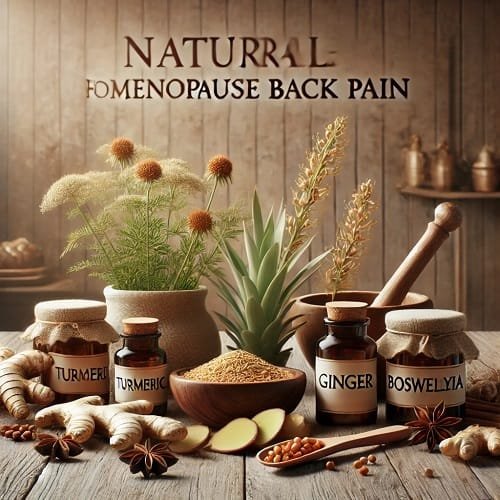
For those seeking how to treat menopause back pain through natural methods, several natural remedies can provide significant relief. These remedies often focus on reducing inflammation, relaxing muscles, and promoting overall well-being. Let’s explore some popular natural solutions for managing back pain during menopause.
Herbal Remedies
Herbs have been used for centuries to treat various ailments, including back pain. Some of the most effective herbal treatments for menopause back pain include turmeric, ginger, and boswellia. These herbs are known for their strong anti-inflammatory properties, which can help reduce swelling and pain in the muscles and joints. Turmeric, in particular, contains curcumin, a compound that has been shown to decrease inflammation and alleviate pain. Ginger also has anti-inflammatory effects and can help ease muscle stiffness and discomfort. Boswellia, an herb derived from the resin of the frankincense tree, has shown promise in treating chronic pain, including back pain during menopause. Incorporating these herbs into your diet or as supplements can offer an all-natural way to manage discomfort.
Essential Oils
Essential oils are another effective natural remedy for menopause back pain. Oils like lavender and peppermint can be particularly beneficial for relieving muscle tension and reducing pain. Lavender oil is known for its calming properties and can help relax tight muscles in the back, easing discomfort. It also promotes better sleep, which is crucial when dealing with back pain. Peppermint oil, on the other hand, has a cooling effect that can reduce pain and inflammation. Applying these oils through massage or using them in aromatherapy can provide fast-acting relief for back pain during menopause.
Acupuncture
For those seeking more holistic approaches, acupuncture has gained popularity as an alternative treatment for back pain during menopause. Acupuncture involves the insertion of thin needles into specific points on the body to stimulate energy flow and promote healing. Studies have shown that acupuncture can help alleviate pain, reduce muscle stiffness, and improve circulation, making it a viable option for managing menopause back pain. The benefits of acupuncture extend beyond pain relief, as it can also help with stress reduction and emotional well-being, both of which can be impacted by menopause.
Incorporating these natural remedies into your routine is a great way to manage menopause back pain without relying solely on medications. Whether through herbal treatments, essential oils, or acupuncture, these natural options offer safe and effective solutions for back pain relief during menopause.
When to Seek Medical Attention for Menopause Back Pain
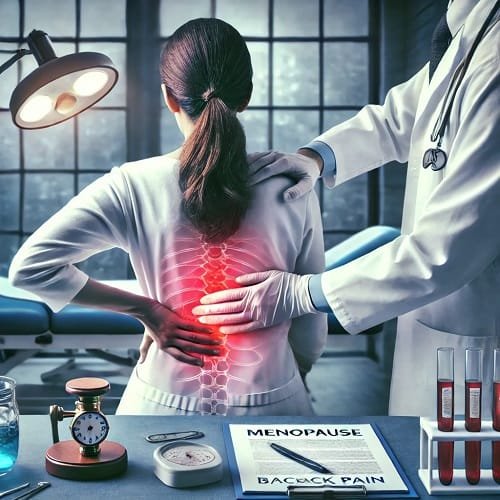
While many women can effectively manage menopause back pain through lifestyle changes and natural remedies, there are times when the pain becomes too severe to handle on your own. Knowing when to seek professional help is crucial for proper treatment and relief.
When Severe Back Pain Requires Medical Intervention
If your menopause back pain becomes severe, constant, or significantly impacts your ability to perform daily tasks, it may be time to consult a doctor. Severe back pain that doesn’t respond to home remedies or worsens over time could indicate an underlying condition that requires professional intervention. If your pain is sharp, stabbing, or accompanied by other symptoms like numbness, tingling, or weakness in the legs, it is important to seek medical attention immediately. These could be signs of nerve involvement or other serious issues.
Consulting a Healthcare Professional
It’s always a good idea to consult with a healthcare professional if your back pain persists for more than a few weeks or interferes with your normal activities. A doctor consultation can help determine the underlying cause of your pain and guide you toward the most effective treatment options. Chronic pain that doesn’t improve with rest, exercise, or over-the-counter medications may require a more detailed assessment.
What to Expect During a Medical Consultation
During your consultation, your doctor will likely begin with a physical examination, evaluating your posture, flexibility, and range of motion. Depending on the severity of your pain, they may recommend imaging tests like X-rays, MRIs, or CT scans to rule out conditions such as fractures, arthritis, or herniated discs. Based on the findings, your doctor might refer you to a specialist, such as a chiropractor, pain management expert, or physical therapist, to help you manage your menopause back pain more effectively.
If you’re wondering how to treat menopause back pain, understanding when to seek medical advice is essential. Consulting a healthcare professional can ensure that you receive the appropriate treatment and prevent more serious conditions from going undiagnosed.
Conclusion
In conclusion, effectively learning how to treat menopause back pain is essential for improving your overall health and quality of life. As menopause brings various challenges, managing back pain is crucial to maintaining daily activities and ensuring that you feel your best during this phase of life. From physical therapy and chiropractic care to natural remedies like herbs and essential oils, there is a wide range of solutions available to help you find relief.
By trying a combination of back pain management techniques, such as exercise, posture correction, and self-care practices, you can significantly alleviate menopause back pain. Always remember, personalized advice from a healthcare provider is invaluable in creating a plan that works best for your body. With the right approach, you can ease menopause pain relief and enhance your comfort and well-being.
Frequently Asked Questions (FAQ)
What are the most effective treatments for menopause back pain?
The most effective treatments include physical therapy, chiropractic care, and natural remedies like herbal supplements and essential oils.
Can natural remedies help with menopause back pain?
Yes, herbs like turmeric and ginger, along with essential oils such as lavender and peppermint, can offer significant relief for menopause back pain.
How can exercise help alleviate menopause-related back pain?
Exercise, particularly low-impact activities like yoga and Pilates, strengthens the core and improves flexibility, which helps alleviate back pain associated with menopause.
When should I see a doctor for menopause back pain?
If your back pain persists for weeks, becomes severe, or is accompanied by other symptoms like numbness or tingling, it’s time to consult a doctor for proper evaluation and treatment.
